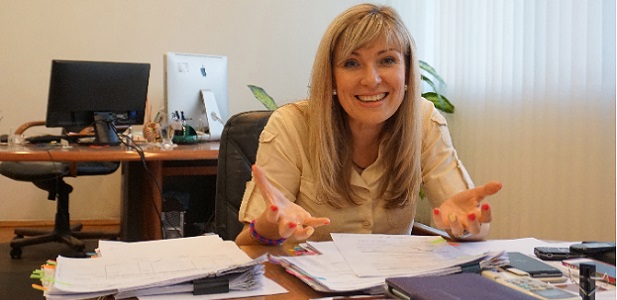
The Republican Central Bank has a governor, a couple of thousand employees and a glass-and-steel headquarters. It also has a bunker in its basement. Here’s what the nascent, self-proclaimed Donetsk People’s Republic in eastern Ukraine is missing: a financial system. Absent from the central bankers’ toolkit are a currency and interest rates.
Set up 11 months ago, the fledgling institution is the first building block by pro-Russian rebels to manage the economy in the vacuum created by the war to break away from Ukraine. Dependent on almost $40 million a month from their patrons in Moscow just to pay pensions and on a circuitous transfer system via another Russian construct in northern Georgia, the Donetsk officials say they’re making progress.
“We are proud that our bank is working, that we made a processing center,” chairwoman Irina Nikitina (photo), 47, a former chief executive officer at a local bank. She spoke in her office at a building the rebels took over from Ukraine’s Eximbank. “We built the system, we want to improve it.”
Two people in the rebel administration said Russia transfers 2.5 billion rubles ($37 million) for pensions every month. They declined to be identified, citing security concerns. So far, the slump in Russian finances hasn’t hit them, Nikitina said.
Back at the offices of the Republican Central Bank, Nikitina oversees about 2,000 employees, roughly equal to about three-quarters of the European Central Bank’s work force in Frankfurt. The Donetsk entity acts more like a monopoly commercial bank as the aspiring policy makers learn the ropes. Her deputy, Yury Dmitrenko, said they mostly surf the Internet to learn about central banking mechanisms, using Russian, Ukrainian, Belarusian and European examples.
A prominent local politician announced plans in December for Donetsk to print its own money, banknotes called “nominal symbols of Novorossiya,” though there’s been no word since as the ruble replaced the hryvnia as the de facto currency. Rubles make up 90 percent of local currency stock, according to the central bank.
Its network of nine ATMs now only service ministerial workers, according to Nikitina. The ATMs display a military monument, a Soviet-style tribute to the fighting in Donetsk. The machines accept only local cards and the only operation is withdrawal. Some 300,000 cards are ready for issue, Nikitina said.
“We are optimists,” she said. “We are sure that our cards will be soon used even abroad.”
Source: Bloomberg
Banking 4.0 – „how was the experience for you”
„To be honest I think that Sinaia, your conference, is much better then Davos.”
Many more interesting quotes in the video below: